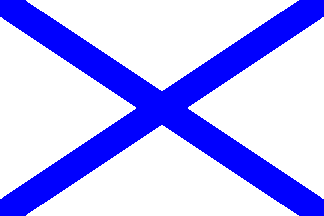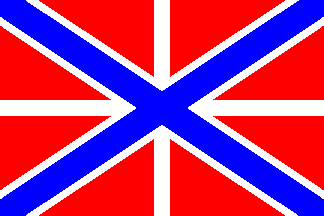
Last modified: 2008-01-12 by antónio martins
Keywords: navy | ensign | jack | fortress flag | pennant | first commander | broad pennant |
Links: FOTW homepage |
search |
disclaimer and copyright |
write us |
mirrors
The Order of St. Andrew, instituted by Tsar Peter I in 1699 to honor the
patron of Russia was reflected in numerous flags apparently designed by the
Tsar himself. The two bottom flags in the manuscript print (left [in the
book]) date from that year. The blue saltire on white of
both is the reverse of the Scottish version of the St. Andrew’s cross.
The Russian jack shows this saltire against a red field
bearing a white cross: the resemblance to the British Union
Jack may have been intentional.
Wayne J. Lovett, 24 Aug 2000,
quoting from [smi75c]

Stern flag [i.e. ensign] (1710-1712)
Željko Heimer, 06 Apr 1999, quoting from
Flag-znamya korablya,
Russian Navy website, consulted 07 Mar 1999

Stern Andrew’s flag [i.e. St. Andrew’s ensign]
(1712-1917), (1992-today)
Željko Heimer, 06 Apr 1999, quoting from
Flag-znamya korablya,
Russian Navy website, consulted 07 Mar 1999
According to [zig94], both flags [ensign and jack] were drawn by Peter the Great:
«The military poop flag is white, with a full-sized blue cross of St.Andrew, because the Christianity became to Russian people from this apostle», explained Peter the Great in 1712.Giuseppe Bottasini
Symbolism of Andreevsky Flag was also Peter’s
contribution to his father — tsar Alexei Mikhailovich
who instituted the special flag
- dark red two-headed
eagle on white-blue-red cloth — for the first military
Russian vessel — three-mast galiot Eagle.
Edward Mooney, 14 Mar 1999, quoting from
Russian
Navy website
Since the Treaty of Kioutsouk Kainartzi in 1774,
Greek merchant vessels could (and
did almost to the exclusion of any other flag until 1821) use
the Russian naval ensign (St.
Andrew’s cross). They even continued so throughout the
XIXth century when in Turkish waters.
Constantine Plakidas, 16 April 2003

Jack and fortress flag (1700-1917),
(1992-today)
Željko Heimer, 06 Apr 1999, quoting from
Flag-znamya korablya,
Russian Navy website, consulted 07 Mar 1999
Like the UK’s Union Jack incorporates the red
St. George’s cross of England as the central figure, the Russian jack
uses their blue St. Andrew’s cross (from the naval
ensign) as its central figure. St. Andrew is also the patron saint of
Russia.
David Lewellen
This flag was hoisted since 1701 on the navy’s
fortresses, since 1720 on bowsprits too. It was a
red flag crossed by a narrow white cross; over all
there was a white-bordered blue St.Andrew cross. It
was drawn by Peter the Great. It was named
Kejzer-flag, i.e. "imperial flag". It was
clearly based on the British "Union" and put together
the white cross of an old Dragons’ flag with the
navy’s St.Andrew flag. The KEJZER-FLAG was so popular
that it was also used on the Soviet Navy till 1924.
Giuseppe Bottasini, quoting
[zig94]
According to many authors the meaning of the red field
is obscure, but to Ziggioto
is clear: it was the third national color.
Giuseppe Bottasini

Pennant (1732-1765 and 1797-1865)
Željko Heimer, 06 Apr 1999, quoting from
Flag-znamya korablya,
Russian Navy website, consulted 07 Mar 1999

Pennant (1732-1865 and 1865-1917)
Željko Heimer, 06 Apr 1999, quoting from
Flag-znamya korablya,
Russian Navy website, consulted 07 Mar 1999

Pennant (1743-1865)
Željko Heimer, 06 Apr 1999, quoting from
Flag-znamya korablya,
Russian Navy website, consulted 07 Mar 1999

Broad-pennant of the first commander [?]
Željko Heimer, 06 Apr 1999, quoting from
Flag-znamya korablya,
Russian Navy website, consulted 07 Mar 1999
Anything below this line was not added by the editor of this page.